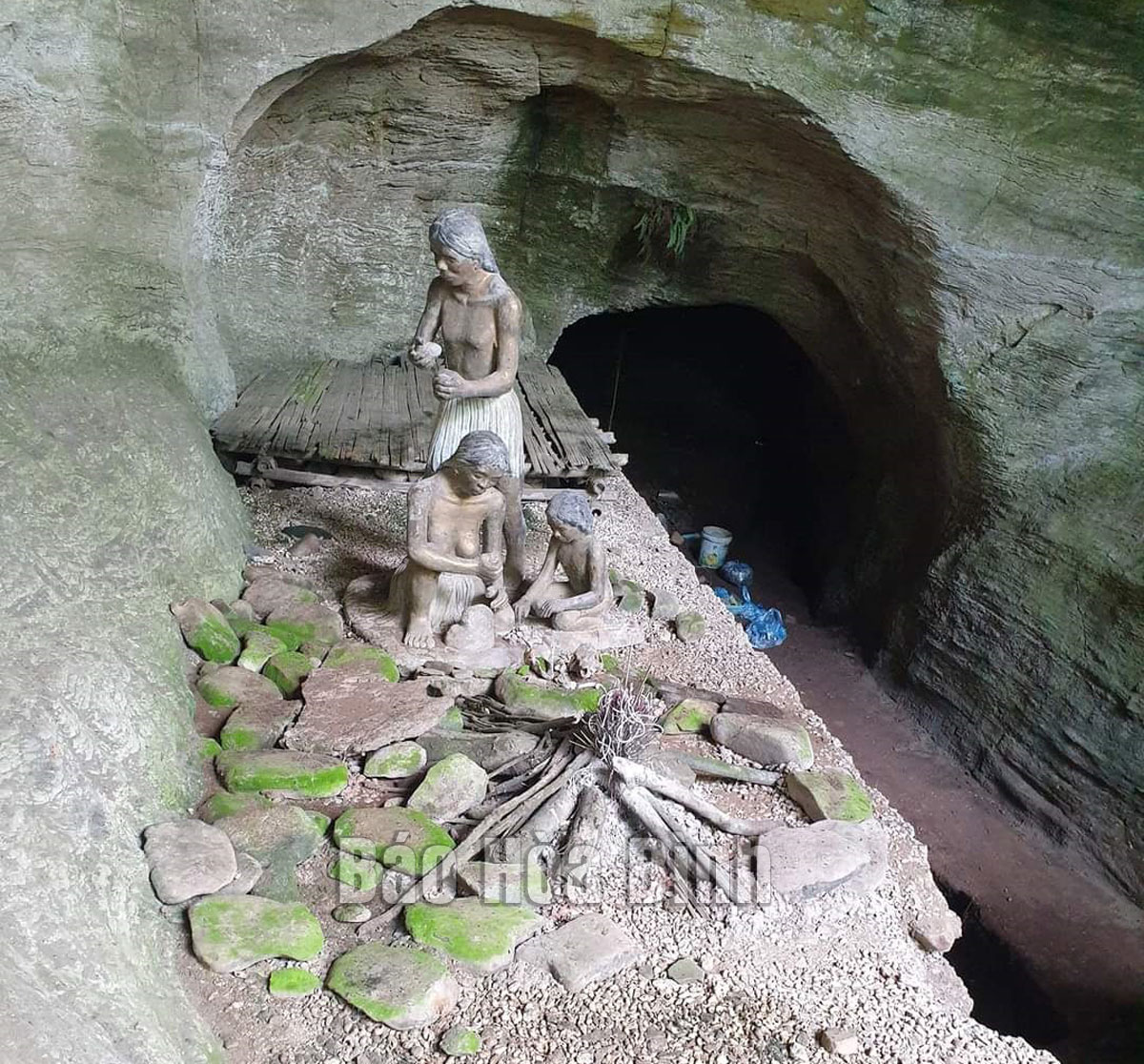
(HBO) – The Hoa Binh Civilisation, dating back to the Stone Age, was discovered by French archaeologist Madeleine Colani and named after the cave relics found in the karst areas of Hoa Binh province. In Vietnam, its traces have been unearthed mostly in Hoa Binh and Thanh Hoa provinces (over 80% of the total relics), while the rest scatter in the provinces of Thai Nguyen, Lai Chau, Son La, Ninh Binh, Ha Nam, Nghe An, Ha Tinh, Quang Ninh, Quang Binh, Quang Tri, and some others. Not only in Vietnam, this civilisation also existed across the mainland Southeast Asia, from southern China to Sumatra Island of Indonesia, Myanmar, and the Philippines.
A demonstration of the life of primitive humans at Xom
Trai Cave in Tan Lap commune, Lac Son district.
The reason for the concentration of Hoa Binh
Civilisation relics in Hoa Binh and Thanh Hoa is that local karst areas had
stable and consistent geological features, and they were also located in the
transition zone of the northern, western and southern geological regions. That
blessed the two provinces with diverse and complex natural conditions as well
as creature richness, resulting in food abundance.
Caves and rock shelters of the Hoa Binh
Civilisation were located at about 15 - 20 metres above the valley’s bed. The
residential space of people at that time varied according to relic sites. Some
caves and shelters are 10 square metres wide while others cover thousands of
square metres, but most have an area of 50 - 150 square metres. Those places
were also lit and warmed by sunlight in the morning. More than 90% of those
sites could keep their inhabitants from cold northwest winds in winter.
Late Professor Tran Quoc Vuong highly valued the
residential locations of the Hoa Binh Civilisation people, saying those places
were the prerequisite for primitive humans to develop agriculture and move to
lowland areas to develop a new civilisation.
Archaeological documents and excavations showed
that hunting and foraging were the main ways of subsistence of people of this
civilisation. Those activities mainly took place in valleys.
Working tools in the Hoa Binh Civilisation were
made from wood, bamboo and pebble. When finding places to reside in, apart from
choosing the sites with necessary natural conditions like sunlight, rivers, and
streams, people at that time also paid special attention to those near pebble
and limestone sources to make working tools.
Archaeological findings also revealed that women
played the main role in creating working tools while men were in charge of
hunting. Women also hunted small animals and mollusk, and picked vegetables and
fruit, which were not as hard as men’s work but generated high economic value.
Women were also responsible for bringing up children, sustaining fire, cooking,
and storing food. Therefore, women’s role gradually became important and
indispensable in each cave of primitive humans.
Ninety years have passed since the discovery of
the Hoa Binh Civilisation, but there remain a number of questions waiting for
answers about this civilisation before a panorama of the society in that period
could take shape./.
Phong Phu commune, Tan Lac district of Hoa Binh province, is widely regarded as the cultural heartland of the Muong ethnic group. Among its many traditional communities, Luy Ai hamlet (formerly Ai hamlet) stands out as a rare location where the customs and way of life of the Muong Bi people remain largely intact.
The Truong Kha temple festival, a distinctive cultural event held every three years in Vu Ban township, Lac Son district, returned recently with vibrant rituals and folk traditions of the Muong people. Located next to the Buoi River in the Muong Trao fields, the Truong Kha Temple is dedicated to the three Kun Dol deities, revered for teaching farming techniques, irrigation, weaving, and protecting the harvest.
The demand for spaces serving community activities of residents in various areas across Hoa Binh city has been satisfied as local cultural houses now feature modern, spacious facilities thanks to the effective implementation of Resolution No. 49/NQ-HDND issued on December 28, 2021 by the city People's Council, which approved the plan for reorganising, converting, and allocating land for the construction, repair, and expansion of cultural houses in Hoa Binh’s villages and residential areas until 2025.
At the end of May, the Hoa Binh Provincial Ethnic Arts Troupe organized a series of performances for residents in Region 2 and Region 3 communes across the province. Bringing art to ethnic communities in remote, isolated, and especially disadvantaged areas has become a meaningful activity. These are not merely artistic performances but also journeys to disseminate cultural values, enrich spiritual life, and contribute to preserving the cultural identity of ethnic minorities.



